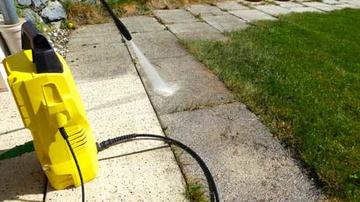
The best way of keeping any path or paving clean and in good condition is basic tools and hard work. If the paving is in reasonable condition, all you need to do is remove any plant growth, brush off and then scrub with plenty of soapy water and a traditional heavy-duty wooden deck brush with short hard bristles, short head and long handle. Use the mechanical action of the brush alongside the chemical action of the soap to loosen any surface detritus.
The soapy water can be swilled onto the paving. It does not matter if it is hot or cold. Use washing-up liquid or an acid-free soap-based floor cleaning product. Soft brushes will not achieve the same effect. After scrubbing, wash off the loosened dirt with clean water from a bucket or hose.
Once paving has been cleaned, it makes sense to keep it that way by brushing regularly.
Algae, Mosses and Lichens
If the paving is not new, it may have algae, mosses and lichens growing on it. The most common is green algae. These are colonies of very simple plants that find a home where rainwater dissolves basic minerals from the paving, which they then absorb and use to grow. These colonies are usually simple to remove with bleach.
Cheap, thin household bleach is ideal. Thick bleach has other things including detergent, thickener and scent added. These make it better for cleaning toilets but less suitable for garden use – thin bleach will eventually evaporate whereas thick bleach could leave chemical residue behind.
Mix a generous squeeze of bleach into a watering can or bucket, fill it up with cold water and apply to the surface. Always add the bleach to the water, not vice versa. This reduces the risk of splashing.
Leave it to work its magic on the algae for a few minutes, and then rinse off with plenty of clean water. The bleach will be effectively neutralised by dilution. It may take several treatments to eliminate stubborn algal colonies, and in the longer term it's a good idea to repeat the treatment every two or three months to deter any re-colonisation.
Be aware that bleach kills other plants as well as algae, possibly including your bedding display or a nearby lawn. Always dilute it with equal volumes of clean water before applying, and make sure there is plenty of clean water readily available to dilute and neutralise any accidental spillages, as well as for cleaning off the treated pavement.
Stubborn customers
If the paving has more stubborn algae, mosses and lichens, professional surface biocide products on the market can used. There are also many products available that claim to do this but do not contain a biocide, as any product containing a biocide must be fully registered with the Health & Safety Executive. Follow the manufacturer’s guidance and be aware that biocidal products can damage certain materials if used regularly.
Power washing
The ubiquitous power washer has become a standard, must-have appliance. If used properly these can help keep paving in good condition, but used wrongly or to excess they can ruin paving and considerably shorten its life, especially if the high-pressure water jet of a ‘Turbo-Lance’ is allowed to remove critical jointing material.

Be careful not to blow out the mortar joints between paving slabs. This will start an irreversible cycle of undermining the paving, which will become unstable and eventually will need to be re-laid There are accessories that are kinder to paving while still cleaning to a satisfactory standard – a patio head cleaner such as the one illustrated below.

Back to basics
Although regular cleaning with basic methods may initially seem like hard work, it will reward the user with better kept and maintained paving.
Footnote: acid warning
Avoid acid-based cleaning products whenever possible – they do more harm than good. In particular, do not use ‘Brick Cleaning Acid’, or any patio cleaner that lists hydrochloric acid among its ingredients, or other acids such as muriatic. They may clean your paving, but there's also a significant risk that they'll ruin it and harm the user.


